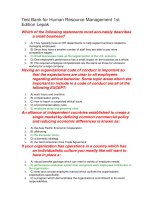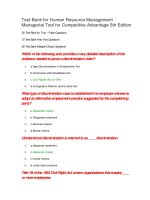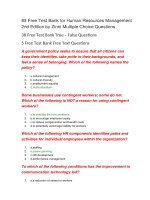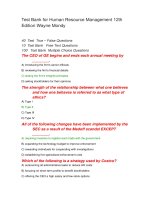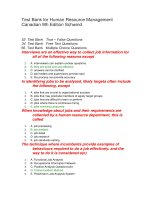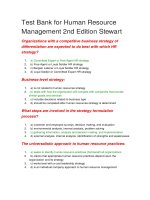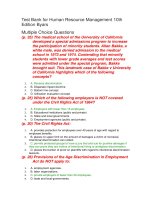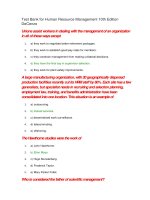Test bank for human anatomy physiology, 9e
Bạn đang xem bản rút gọn của tài liệu. Xem và tải ngay bản đầy đủ của tài liệu tại đây (1.59 MB, 31 trang )
full file at
Exam
Name___________________________________
MULTIPLE CHOICE. Choose the one alternative that best completes the statement or answers the question.
1) What is the role of calcium ions in muscle contraction?
A) increase levels of myoglobin
B) reestablish glycogen stores
C) bind to regulatory sites on troponin to remove contraction inhibition
D) form hydroxyapatite crystals
Answer: C
Explanation:
A)
B)
C)
D)
2) Of the following muscle types, which has only one nucleus, no sarcomeres, and rare gap junctions?
A) cardiac muscle
B) multiunit smooth muscle
C) skeletal muscle
D) visceral smooth muscle
Answer: B
Explanation:
3)
A)
B)
C)
D)
4) Rigor mortis occurs because ________.
A) the cells are dead
B) sodium ions leak into the muscle causing continued contractions
C) proteins are beginning to break down, thus preventing a flow of calcium ions
D) no ATP is available to release attached actin and myosin molecules
Answer: D
Explanation:
2)
A)
B)
C)
D)
3) Which of the following is not a connective tissue sheath that wraps individual muscle fibers?
A) perimysium
B) epimysium
C) aponeurosis
D) endomysium
Answer: C
Explanation:
1)
A)
B)
C)
D)
1
4)
full file at
5) When a muscle is unable to respond to stimuli temporarily, it is in which of the following periods?
A) relaxation period
B) latent period
C) refractory period
D) fatigue period
Answer: C
Explanation:
A)
B)
C)
D)
6) What is the functional role of the T tubules?
A) hold cross bridges in place in a resting muscle
B) enhance cellular communication during muscle contraction
C) stabilize the G and F actin
D) synthesize ATP to provide energy for muscle contraction
Answer: B
Explanation:
6)
A)
B)
C)
D)
7) In an isotonic contraction, the muscle ________.
A) rapidly resynthesizes creatine phosphate and ATP
B) changes in length and moves the "load"
C) never converts pyruvate to lactate
D) does not change in length but increases tension
Answer: B
Explanation:
7)
A)
B)
C)
D)
8) An anaerobic metabolic pathway that results in the production of two net ATPs per glucose plus
two pyruvic acid molecules is ________.
A) the citric acid cycle
B) glycolysis
C) the electron transport chain
D) hydrolysis
Answer: B
Explanation:
8)
A)
B)
C)
D)
9) The contractile units of skeletal muscles are ________.
A) myofibrils
B) T tubules
C) mitochondria
Answer: A
Explanation:
5)
A)
B)
C)
D)
2
D) microtubules
9)
full file at
10) Which of the following is not a component of the standard treatment for muscle strain?
A) elevation of the limb
B) rest of the muscle
C) ice on the muscle
D) stretching of the muscle
Answer: D
Explanation:
A)
B)
C)
D)
11) Which muscle cells have the greatest ability to regenerate?
A) skeletal
B) cardiac
C) no muscle can regenerate
D) smooth
Answer: D
Explanation:
13)
A)
B)
C)
D)
14) What is the primary function of wave summation?
A) produce smooth, continuous muscle contraction
B) prevent muscle fatigue
C) prevent muscle relaxation
D) increase muscle tension
Answer: A
Explanation:
12)
A)
B)
C)
D)
13) Which of the following statements is most accurate?
A) The I band lengthens during isotonic contraction.
B) Muscle tension remains relatively constant during isotonic contraction.
C) T tubules may be sliding during isotonic contraction.
D) Myofilaments slide during isometric contractions.
Answer: B
Explanation:
11)
A)
B)
C)
D)
12) Which of the following is a factor that affects the velocity and duration of muscle
contraction?
A) load on the fiber
B) number of muscle fibers stimulated
C) size of the muscle fibers stimulated
D) muscle length
Answer: A
Explanation:
10)
A)
B)
C)
D)
3
14)
full file at
15) Smooth muscle is characterized by all of the following except ________.
A) there are more thick filaments than thin filaments
B) it appears to lack troponin
C) there are noncontractile intermediate filaments that attach to dense bodies within the cell
D) there are no sarcomeres
Answer: A
Explanation:
A)
B)
C)
D)
16) Which of the following statements is false or incorrect?
A) Cardiac muscle contracts when stimulated by its own autorhythmic muscle cells.
B) Cardiac muscle fibers depend mostly on anaerobic cellular respiration to generate ATP.
C) Under normal resting conditions, cardiac muscle tissue contracts and relaxes about 75 times
per minute.
D) Cardiac muscle fibers can use lactic acid to make ATP.
Answer: B
Explanation:
17)
A)
B)
C)
D)
18) During vigorous exercise, there may be insufficient oxygen available to completely break down
pyruvic acid for energy. As a result, the pyruvic acid is converted to ________.
A) hydrochloric acid
B) a strong base
C) lactic acid
D) stearic acid
Answer: C
Explanation:
16)
A)
B)
C)
D)
17) After nervous stimulation stops, what prevents ACh in the synaptic cleft from continuing to
stimulate contraction?
A) the action potential stops going down the overloaded T tubules
B) acetylcholinesterase destroying the ACh
C) calcium ions returning to the terminal cisternae
D) the tropomyosin blocking the myosin once full contraction is achieved
Answer: B
Explanation:
15)
A)
B)
C)
D)
4
18)
full file at
19) Most skeletal muscles contain ________.
A) a predominance of fast oxidative fibers
C) muscle fibers of the same type
Answer: D
Explanation:
B) a predominance of slow oxidative fibers
D) a mixture of fiber types
A)
B)
C)
D)
20) What produces the striations of a skeletal muscle cell?
A) a difference in the thickness of the sarcolemma
B) the T tubules
C) the sarcoplasmic reticulum
D) the arrangement of myofilaments
Answer: D
Explanation:
20)
A)
B)
C)
D)
21) Hypothetically, if a muscle were stretched to the point where thick and thin filaments no longer
overlapped, ________.
A) cross bridge attachment would be optimum because of all the free binding sites on actin
B) maximum force production would result because the muscle has a maximum range of travel
C) ATP consumption would increase because the sarcomere is "trying" to contract
D) no muscle tension could be generated
Answer: D
Explanation:
D) fascicle
22)
A)
B)
C)
D)
23) Immediately following the arrival of the stimulus at a skeletal muscle cell there is a short period
called the ________ period during which the neurotransmitter is released by exocytosis, diffuses
across the synaptic cleft, and binds to its receptors.
A) relaxation
B) latent
C) refractory
D) contraction
Answer: B
Explanation:
21)
A)
B)
C)
D)
22) Which of the following surrounds the individual muscle cell?
A) endomysium
B) perimysium
C) epimysium
Answer: A
Explanation:
19)
A)
B)
C)
D)
5
23)
full file at
24) The muscle cell membrane is called the ________.
A) sarcolemma
B) epimysium
Answer: A
Explanation:
C) perimysium
D) endomysium
A)
B)
C)
D)
25) The term aponeurosis refers to ________.
A) the bands of myofibrils
B) the rough endoplasmic reticulum
C) the tropomyosin-troponin complex
D) a sheetlike indirect attachment to a skeletal element
Answer: D
Explanation:
25)
A)
B)
C)
D)
26) Which of the following is not a role of ionic calcium in muscle contraction?
A) activates epinephrine released from adrenal gland
B) triggers neurotransmitter secretion
C) removes contraction inhibitor
D) binds with troponin
Answer: A
Explanation:
D) hemoglobin
27)
A)
B)
C)
D)
28) During muscle contraction, myosin cross bridges attach to which active sites?
A) actin filaments
B) myosin filaments
C) Z discs
D) thick filaments
Answer: A
Explanation:
26)
A)
B)
C)
D)
27) The oxygen-binding protein found in muscle cells is ________.
A) myoglobin
B) immunoglobin
C) ATP
Answer: A
Explanation:
24)
A)
B)
C)
D)
6
28)
full file at
29) Excitation-contraction coupling requires which of the following substances?
A) Ca2+ only
B) ATP only
C) ATP and glucose
D) Ca2+ and ATP
Answer: D
Explanation:
A)
B)
C)
D)
30) Muscle tone is ________.
A) the condition of athletes after intensive training
B) the feeling of well-being following exercise
C) a state of sustained partial contraction
D) the ability of a muscle to efficiently cause skeletal movements
Answer: C
Explanation:
32)
A)
B)
C)
D)
33) Three discrete types of muscle fibers are identified on the basis of their size, speed, and endurance.
Which of the following athletic endeavors best represents the use of red fibers?
A) gym climbing
B) a long, relaxing swim
C) playing baseball or basketball
D) a sprint by an Olympic runner
Answer: B
Explanation:
31)
A)
B)
C)
D)
32) The major function of the sarcoplasmic reticulum in muscle contraction is to ________.
A) provide a source of myosin for the contraction process
B) regulate intracellular calcium concentration
C) make and store phosphocreatine
D) synthesize actin and myosin myofilaments
Answer: B
Explanation:
30)
A)
B)
C)
D)
31) What structure in skeletal muscle cells functions in calcium storage?
A) myofibrillar network
B) mitochondria
C) intermediate filament network
D) sarcoplasmic reticulum
Answer: D
Explanation:
29)
A)
B)
C)
D)
7
33)
full file at
34) The giant protein titin maintains the organization of the ________ assisting in muscle stretching.
A) M line
B) Z disc
C) I band
D) A band
Answer: D
Explanation:
A)
B)
C)
D)
35) Which of the following describes the cells of unitary smooth muscle?
A) They are used for vision and hair raising.
B) They exhibit spontaneous action potentials.
C) They depend upon recruitment using the autonomic nervous system.
D) They consist of muscle fibers that are structurally independent of each other.
Answer: B
Explanation:
37)
A)
B)
C)
D)
38) Fatigued muscle cells that recover rapidly are the products of ________.
A) slow exercise of short duration
B) intense exercise of short duration
C) intense exercise of long duration
D) slow exercise of long duration
Answer: B
Explanation:
36)
A)
B)
C)
D)
37) Myoglobin ________.
A) is a protein involved in the direct phosphorylation of ADP
B) stores oxygen in muscle cells
C) produces the end plate potential
D) breaks down glycogen
Answer: B
Explanation:
35)
A)
B)
C)
D)
36) What is the most distinguishing characteristic of muscle tissue?
A) the ability to transform chemical energy into mechanical energy
B) the diversity of activity of muscle tissue
C) the ability to respond to nervous stimulation
D) the design of the fibers
Answer: A
Explanation:
34)
A)
B)
C)
D)
8
38)
full file at
39) Which of the following is the correct sequence of events for muscle contractions?
A) motor neuron action potential, neurotransmitter release, muscle cell action potential, release
of calcium ions from SR, ATP-driven power stroke, sliding of myofilaments
B) neurotransmitter release, motor neuron action potential, muscle cell action potential, release
of calcium ions from SR, ATP-driven power stroke
C) neurotransmitter release, muscle cell action potential, motor neuron action potential, release
of calcium ions from SR, sliding of myofilaments, ATP-driven power stroke
D) muscle cell action potential, neurotransmitter release, ATP-driven power stroke, calcium ion
release from SR, sliding of myofilaments
Answer: A
Explanation:
A)
B)
C)
D)
40) Muscle tissue has all of the following properties except ________.
A) secretion
B) contractility
C) excitability
Answer: A
Explanation:
D) extensibility
41)
A)
B)
C)
D)
42) Creatine phosphate functions in the muscle cell by ________.
A) inducing a conformational change in the myofilaments
B) storing energy that will be transferred to ADP to resynthesize ATP
C) forming a chemical compound with actin
D) forming a temporary chemical compound with myosin
Answer: B
Explanation:
40)
A)
B)
C)
D)
41) What part of the sarcolemma contains acetylcholine receptors?
A) end of the muscle fiber
B) motor end plate
C) part adjacent to another muscle cell
D) any part of the sarcolemma
Answer: B
Explanation:
39)
A)
B)
C)
D)
9
42)
full file at
43) What does excess postexercise oxygen consumption represent?
A) the difference between the amount of oxygen needed for totally aerobic muscle activity and
the amount actually used
B) amount of oxygen needed for aerobic activity to accomplish the same amount of work
C) the amount of oxygen equal to the oxygen already used
D) the amount of oxygen taken into the body immediately after the exertion
Answer: A
Explanation:
A)
B)
C)
D)
44) What is the functional unit of a skeletal muscle called?
A) a myofibril
B) a sarcomere
C) the sarcoplasmic reticulum
D) a myofilament
Answer: B
Explanation:
45)
A)
B)
C)
D)
46) Which of the following statements is true?
A) Cardiac muscle cells are found in the heart and large blood vessels.
B) Smooth muscle cells have T tubules.
C) Cardiac muscle cells have many nuclei.
D) Striated muscle cells are long and cylindrical with many nuclei.
Answer: D
Explanation:
44)
A)
B)
C)
D)
45) Which of the choices below does not describe how excess postexercise oxygen consumption
(oxygen deficit) restores metabolic conditions?
A) replaces the oxygen removed from myoglobin
B) converts lactic acid back into glycogen stores in the liver
C) resynthesizes creatine phosphate and ATP in muscle fibers
D) increases the level of lactic acid in the muscle
Answer: D
Explanation:
43)
A)
B)
C)
D)
10
46)
full file at
47) The mechanism of contraction in smooth muscle is different from skeletal muscle in that ________.
A) ATP energizes the sliding process
B) actin and myosin interact by the sliding filament mechanism
C) the site of calcium regulation differs
D) the trigger for contraction is a rise in intracellular calcium
Answer: C
Explanation:
A)
B)
C)
D)
48) Which of the following would be recruited later in muscle stimulation when contractile strength
increases?
A) motor units with larger, less excitable neurons
B) many small motor units with the ability to stimulate other motor units
C) motor units with the longest muscle fibers
D) large motor units with small, highly excitable neurons
Answer: A
Explanation:
49)
A)
B)
C)
D)
50) The strongest muscle contractions are normally achieved by ________.
A) recruiting small and medium muscle fibers
B) increasing stimulus above the threshold
C) increasing stimulus above the treppe stimulus
D) increasing the stimulation up to the maximal stimulus
Answer: D
Explanation:
48)
A)
B)
C)
D)
49) Which of the following is true about smooth muscle?
A) Certain smooth muscle cells can actually divide to increase their numbers.
B) Smooth muscle cannot stretch as much as skeletal muscle.
C) Smooth muscle, in contrast to skeletal muscle, cannot synthesize or secrete any connective
tissue elements.
D) Smooth muscle has well-developed T tubules at the site of invagination.
Answer: A
Explanation:
47)
A)
B)
C)
D)
11
50)
full file at
51) What is the role of tropomyosin in skeletal muscles?
A) Tropomyosin serves as a contraction inhibitor by blocking the actin binding sites on the
myosin molecules.
B) Tropomyosin is the chemical that activates the myosin heads.
C) Tropomyosin is the receptor for the motor neuron neurotransmitter.
D) Tropomyosin serves as a contraction inhibitor by blocking the myosin binding sites on the
actin molecules.
Answer: D
Explanation:
A)
B)
C)
D)
52) The sliding filament model of contraction involves ________.
A) the Z discs sliding over the myofilaments
B) actin and myosin sliding past each other and partially overlapping
C) the shortening of thick filaments so that thin filaments slide past
D) actin and myosin lengthening in order to slide past each other
Answer: B
Explanation:
51)
52)
A)
B)
C)
D)
SHORT ANSWER. Write the word or phrase that best completes each statement or answers the question.
53) Define physiologic muscle fatigue.
53)
Answer: It is an inability of the muscle to contract despite continued stimulation.
Explanation:
54) What are caveolae?
54)
Answer: Folds on the surface of smooth muscle cells that correspond to T tubules in skeletal
muscle cells.
Explanation:
55) In the synaptic cleft of a neuromuscular junction, an enzyme called ________ is always
present.
Answer: acetylcholinesterase
Explanation:
12
55)
full file at
Figure 9.2
Using Figure 9.2, match the following:
56) H zone.
56)
Answer: B
Explanation:
57) What ultimately stops muscle stimulation when the motor neuron ceases firing?
Answer: The ultimate switch is the enzyme acetylcholinesterase. When the neuron stops
releasing ACh, the muscle would not stop contracting if the acetylcholinesterase did
not split the ACh into its two components, acetic acid and choline, making them
release their binding sites.
Explanation:
13
57)
full file at
Figure 9.2
Using Figure 9.2, match the following:
58) M line.
58)
Answer: E
Explanation:
14
full file at
Figure 9.1
Using Figure 9.1, match the following:
59) Bundle of muscle cells surrounded by a perimysium
59)
Answer: D
Explanation:
60) The time in which cross bridges are active is called the period of ________.
60)
Answer: contraction
Explanation:
61) What is muscle tension?
61)
Answer: Muscle tension is the force exerted by a contracting muscle on an object.
Explanation:
62) What are the parts of the skeletal muscle triad and what are their functions?
Answer: The parts of the muscle triad are two adjacent SR terminal cisterns plus one
intervening T tubule. The sarcoplasmic reticulum is a reservoir for calcium ions in
the cell's normal resting state. The T tubule is a fold in the cell membrane between
the sarcoplasmic reticuli. When an impulse is activated by a motor neuron, the
voltage-regulated change causes SR foot proteins to open Ca2+ channels. The
calcium ions are flushed out where they interact with the troponin complex to
initiate a contraction. Once the axon stops firing, the membrane polarity is quickly
restored and the calcium ions are pulled off the troponin and attracted back into the
sarcoplasmic reticulum.
Explanation:
15
62)
full file at
63) The end of the muscle that typically moves when a muscle contracts is called the ________.
63)
Answer: insertion
Explanation:
Figure 9.2
Using Figure 9.2, match the following:
64) Z disc.
64)
Answer: A
Explanation:
65) A smooth, sustained contraction from rapid stimulation is called ________.
Answer: tetanus
Explanation:
16
65)
full file at
Figure 9.2
Using Figure 9.2, match the following:
66) I band.
66)
Answer: C
Explanation:
17
full file at
Figure 9.1
Using Figure 9.1, match the following:
67) Individual muscle fiber.
67)
Answer: C
Explanation:
68) Connective tissue surrounding muscle fiber bundles
68)
Answer: E
Explanation:
69) Only ________ muscle cells are always multinucleated.
69)
Answer: skeletal
Explanation:
70) Briefly explain the sources of energy for a one-minute sustained muscle contraction.
Answer: 1. The first 4-6 seconds of energy come from stored ATP in the muscle cell.
2. 6-15 seconds of energy come from the transfer of creatine phosphate and ADP
(which come from the first few seconds of burn) to form additional ATP.
3. 15-60 seconds of energy come from glycolysis, which by now has begun full
production of ATP from glucose.
Explanation:
18
70)
full file at
Figure 9.2
Using Figure 9.2, match the following:
71) A band.
71)
Answer: D
Explanation:
72) How is it that norepinephrine (NE) can inhibit smooth muscle action in airways, yet
stimulate contractions in smooth muscles everywhere else in the body?
72)
Answer: Norepinephrine's effects depend upon the action of the receptor to which it
binds.There is a different type of NE receptor on bronchiolar muscle than the NE
receptor in other places..
Explanation:
73) How do the three muscle types respond to being stretched?
73)
Answer: All three muscle types initially respond by contracting more forcefully, then
relaxing. However, smooth muscle possesses a latch state in which it can maintain
its new length while relaxed.
Explanation:
74) Compare red and white muscles relative to their speed of action and endurance.
74)
Answer: Red muscles tend to have a slow (oxidative) rate and fatigue resistance, whereas
white muscle cells have a fast (oxidative) rate and fatigue easily.
Explanation:
75) Briefly, what causes rigor mortis?
75)
Answer: Following the death of an individual, ATP is rapidly consumed and cannot be
replaced. Because cross bridge detachment and calcium active transport is ATP
driven, calcium leakage from the sarcoplasmic reticulum causes attachment of cross
bridges, and lack of ATP prevents detachments.
Explanation:
19
full file at
76) Which cells help repair injured skeletal muscle fibers and allow regeneration of dead
skeletal muscle?
76)
Answer: satellite cells
Explanation:
Figure 9.1
Using Figure 9.1, match the following:
77) Connective tissue covering the exterior of a muscle organ.
77)
Answer: A
Explanation:
78) What is a muscle spasm?
78)
Answer: It is a sudden, involuntary twitch in smooth or skeletal muscle, possibly due to
chemical imbalances.
Explanation:
79) Skeletal muscles have two special inclusions that help them perform their function of
movement. What are the two special inclusions of skeletal muscle cells and how would
they be useful to the cell?
Answer: Skeletal muscle cells require a lot of rapidly available fuel to burn in order to
function properly. They also require a lot of oxygen to burn this fuel efficiently.
Glycosomes store glycogen that can be quickly converted to glucose, which in turn
can be burned to produce ATP. Myoglobin is a chemical much like hemoglobin in
blood cells that can store large quantities of oxygen.
Explanation:
20
79)
full file at
80) Only ________ muscle cells commonly branch.
80)
Answer: cardiac
Explanation:
Figure 9.1
Using Figure 9.1, match the following:
81) Connective tissue sheath surrounding individual muscle fibers
81)
Answer: B
Explanation:
TRUE/FALSE. Write 'T' if the statement is true and 'F' if the statement is false.
82) During isometric contraction, the energy used appears as movement.
Answer:
True
Explanation:
False
83) An increase in the calcium ion level in the sarcoplasm starts the sliding of the thin filaments. When
the level of calcium ions declines, sliding stops.
Answer:
True
Explanation:
83)
False
84) The effect of a neurotransmitter on the muscle cell membrane is to modify its ion permeability
properties temporarily.
Answer:
True
Explanation:
82)
False
21
84)
full file at
85) Muscle cells store more creatine phosphate than ATP resulting in the muscle having a reserve
source of energy.
Answer:
True
Explanation:
False
86) A resting potential is caused by a difference in the concentration of certain ions inside and outside
the cell.
Answer:
True
Explanation:
89)
False
90) Cardiac muscle has a limited regenerative capacity.
Answer:
True
Explanation:
94)
False
95) Muscle contraction will always promote movement of body parts regardless of how they are
attached.
Answer:
True
Explanation:
93)
False
94) A contraction in which the muscle does not shorten but its tension increases is called isometric
contraction.
Answer:
True
Explanation:
92)
False
93) A motor neuron and all the muscle cells that it stimulates are referred to as a motor end plate.
Answer:
True
Explanation:
91)
False
92) One of the functions of skeletal muscle contraction is production of heat.
Answer:
True
Explanation:
90)
False
91) Once a motor neuron has fired, all the muscle fibers in a muscle contract.
Answer:
True
Explanation:
88)
False
89) Peristalsis is characteristic of smooth muscle.
Answer:
True
Explanation:
87)
False
88) Smooth muscles relax when intracellular Ca2+ levels drop but may not cease contractions.
Answer:
True
Explanation:
86)
False
87) Eccentric contractions are more forceful than concentric contractions.
Answer:
True
Explanation:
85)
False
22
95)
full file at
96) When a muscle fiber contracts, the I bands diminish in size, the H zones disappear, and the A
bands do not diminish in length.
Answer:
True
Explanation:
False
97) The thin filaments (actin) contain a polypeptide subunit G actin that bears active sites for myosin
attachment.
Answer:
True
Explanation:
100)
False
101) Cells of unitary smooth muscle are found in the longitudinal and circular muscle layers of the
intestine.
Answer:
True
Explanation:
99)
False
100) The force of muscle contraction is controlled by multiple motor unit summation or recruitment.
Answer:
True
Explanation:
98)
False
99) Although there are no sarcomeres, smooth muscle still possesses thick and thin filaments.
Answer:
True
Explanation:
97)
False
98) Muscle tone is the small amount of tautness or tension in the muscle due to weak, involuntary
contractions of its motor units.
Answer:
True
Explanation:
96)
101)
False
MATCHING. Choose the item in column 2 that best matches each item in column 1.
Match the following:
102) Diffusion across the cell membrane
results in depolarization.
A) Acetylcholinesterase
Answer: B
B) Sodium ions
103) Destroys ACh.
C) Acetylcholine
Answer: A
104) A neurotransmitter released at motor
end plates by the axon terminals.
102)
103)
104)
Answer: C
Match the following:
105) The myosin filaments are located in
the ________.
A) A band
Answer: A
23
105)
full file at
Match the following:
106) The situation in which contractions
become stronger due to stimulation
before complete relaxation occurs.
Answer: B
A) Tetanus
106)
B) Wave summation
107) Continued sustained smooth
contraction due to rapid stimulation.
107)
Answer: A
Match the following:
108) Serves as the actual "trigger" for
muscle contraction by removing the
inhibition of the troponin molecules.
A) Calcium ions
108)
Answer: A
Match the following:
109) Both actin and myosin are found in the
________.
A) A band
109)
Answer: A
Match the sport to the energy system primarily used to perform the activity:
110) Weight lifting
A) Direct phosphorylation
Answer: A
110)
Match the following:
111) The thicker filaments are the ________
filaments.
A) Myosin
111)
Answer: A
Match the following:
112) Activate synaptic vesicles in axon
terminals.
A) Calcium ions
112)
Answer: A
Match the following:
113) Depends on oxygen delivery and
aerobic mechanisms.
A) Slow (oxidative), fatigue-resistant fibers
Answer: A
24
113)
full file at
Match the sport to the energy system primarily used to perform the activity:
114) Marathons
Answer: B
115) 25 meter swim
A) Anaerobic pathway
114)
B) Aerobic pathway
115)
Answer: A
Match the following:
116) How a smooth increase in muscle
force is produced.
A) Multiple motor unit summation
116)
Answer: A
Match the following:
117) Used to convert ADP to ATP by
transfer of a high-energy phosphate
group. A reserve high-energy
compound.
A) Creatine phosphate
117)
Answer: A
Match the following:
118) The ________ contains only the actin
filaments.
A) I band
118)
Answer: A
Match the following:
119) Have very fast-acting myosin
ATPases and depend upon anaerobic
metabolism during contraction.
A) Fast (oxidative or glycolytic), fatigable
fibers
119)
Answer: A
Match the following:
120) Determined by alternating motor units
of a muscle organ even when the
muscle is at rest.
A) Muscle tone
Answer: A
25
120)

